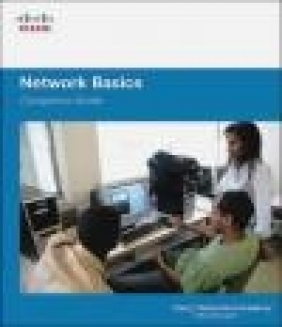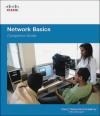Network Basics Companion Guide
Cisco Networking Academy
Network Basics Companion Guide
Cisco Networking Academy
- Producent: Cisco Press
- Rok produkcji: 2013
- ISBN: 9781587133176
- Ilość stron: 744
- Oprawa: Twarda
Niedostępna
Opis: Network Basics Companion Guide - Cisco Networking Academy
Network Basics Companion Guide is the official supplemental textbook for the Network Basics course in the Cisco(R) Networking Academy(R) CCNA(R) Routing and Switching curriculum. Using a top-down OSI model approach, the course introduces the architecture, structure, functions, components, and models of the Internet and computer networks. The principles of IP addressing and fundamentals of Ethernet concepts, media, and operations are introduced to provide a foundation for the curriculum. By the end of the course, you will be able to build simple LANs, perform basic configurations for routers and switches, and implement IP addressing schemes. The Companion Guide is designed as a portable desk reference to use anytime, anywhere to reinforce the material from the course and organize your time. The book's features help you focus on important concepts to succeed in this course: Chapter Objectives-Review core concepts by answering the focus questions listed at the beginning of each chapter. Key Terms-Refer to the lists of networking vocabulary introduced and highlighted in context in each chapter. Glossary-Consult the comprehensive Glossary with more than 250 terms. Summary of Activities and Labs-Maximize your study time with this complete list of all associated practice exercises at the end of each chapter. Check Your Understanding-Evaluate your readiness with the end-ofchapter questions that match the style of questions you see in the online course quizzes. The answer key explains each answer. How To-Look for this icon to study the steps you need to learn to performcertain tasks. Interactive Activities-Reinforce your understanding of topics with more than 50 different exercises from the online course identified throughout the book with this icon. Videos-Watch the videos embedded within the online course. Packet Tracer Activities-Explore and visualize networking concepts using Packet Tracer exercises interspersed throughout the chapters. Hands-on Labs-Work through all 68 course labs and Class Activities that are included in the course and published in the separate Lab Manual.Introduction xxiv Chapter 1 Exploring the Network 1 Objectives 1 Key Terms 1 Introduction (1.0.1.1) 3 Communicating in a Network-Centric World (1.1) 4 Interconnecting Our Lives (1.1.1) 4 Networks in Our Daily Lives (1.1.1.1) 4 Technology Then and Now (1.1.1.2) 5 The Global Community (1.1.1.3) 6 Networks Support the Way We Learn (1.1.1.4) 6 Networks Support the Way We Communicate (1.1.1.5) 7 Networks Support the Way We Work (1.1.1.6) 9 Networks Support the Way We Play (1.1.1.7) 9 Supporting Communication (1.1.2) 10 What Is Communication? (1.1.2.1) 10 Quality of Communication (1.1.2.2) 12 The Network as a Platform (1.2) 13 Converged Networks (1.2.1) 13 Traditional Service Networks (1.2.1.1) 13 Planning for the Future (1.2.1.2) 14 Reliable Network (1.2.2) 15 The Supporting Network Architecture (1.2.2.1) 15 Fault Tolerance in Circuit-Switched Networks (1.2.2.2) 15 Packet-Switched Networks (1.2.2.3) 17 Scalable Networks (1.2.2.4) 18 Providing QoS (1.2.2.5) 20 Providing Network Security (1.2.2.6) 21 LANs, WANs, and the Internet (1.3) 23 Components of a Network (1.3.1) 23 Components of the Network (1.3.1.1) 23 End Devices (1.3.1.2) 24 Intermediary Devices (1.3.1.3) 25 Network Media (1.3.1.4) 25 Network Representations (1.3.1.5) 26 Topology Diagrams (1.3.1.6) 28 LANs and WANs (1.3.2) 28 Types of Networks (1.3.2.1) 28 Local-Area Networks (1.3.2.2) 29 Wide-Area Networks (1.3.2.3) 30 The Internet (1.3.3) 30 The Internet (1.3.3.1) 30 Intranet and Extranet (1.3.3.2) 31 Connecting to the Internet (1.3.4) 32 Internet Access Technologies (1.3.4.1) 32 Connecting Remote Users to the Internet (1.3.4.2) 33 Connecting Businesses to the Internet (1.3.4.3) 34 The Expanding Network (1.4) 35 Network Trends (1.4.1) 36 New Trends (1.4.1.1) 36 Bring Your Own Device (BYOD) (1.4.1.2) 36 BYOD Considerations (1.4.1.3) 37 Online Collaboration (1.4.1.4) 38 Collaboration Considerations (1.4.1.5) 38 Video Communication (1.4.1.6) 39 Cloud Computing (1.4.1.7) 40 Types of Clouds (1.4.1.8) 41 Data Centers (1.4.1.9) 41 Network Security (1.4.2) 42 Security Threats (1.4.2.1) 42 Security Solutions (1.4.2.2) 44 Network Architectures (1.4.3) 45 Cisco Network Architectures (1.4.3.1) 45 Cisco Borderless Network (1.4.3.2) 46 Collaboration Architecture (1.4.3.3) 46 Data Center Architecture (1.4.3.4) 47 CCNA (1.4.3.5) 47 Summary (1.5) 49 Practice 50 Class Activities 50 Labs 50 Packet Tracer Activity 50 Check Your Understanding 50 Chapter 2 Configuring a Network Operating System 55 Objectives 55 Key Terms 55 Introduction (2.0.1.1) 56 IOS Bootcamp (2.1) 56 Cisco IOS (2.1.1) 56 Purpose of OS (2.1.1.1) 56 Location of the Cisco IOS (2.1.1.2) 57 IOS Functions (2.1.1.3) 58 Accessing a Cisco IOS Device (2.1.2) 59 Console Access Method (2.1.2.1) 59 Telnet, SSH, and AUX Access Methods (2.1.2.2) 60 Terminal Emulation Programs (2.1.2.3) 61 Navigating the IOS (2.1.3) 61 Cisco IOS Modes of Operation (2.1.3.1) 62 Primary Modes (2.1.3.2) 63 Global Configuration Mode and Submodes (2.1.3.3) 64 Navigating Between IOS Modes (2.1.3.4, 2.1.3.5) 65 The Command Structure (2.1.4) 66 IOS Command Structure (2.1.4.1) 67 Cisco IOS Command Reference (2.1.4.2) 68 Context-Sensitive Help (2.1.4.3) 70 Command Syntax Check (2.1.4.4) 71 Hot Keys and Shortcuts (2.1.4.5) 72 IOS Examination Commands (2.1.4.6) 74 The show version Command (2.1.4.7) 75 Getting Basic (2.2) 76 Hostnames (2.2.1) 76 Why the Switch (2.2.1.1) 76 Device Names (2.2.1.2) 76 Hostnames (2.2.1.3) 78 Configuring Hostnames (2.2.1.4) 78 Limiting Access to Device Configurations (2.2.2) 79 Securing Device Access (2.2.2.1) 79 Securing Privileged EXEC Access (2.2.2.2) 80 Securing User EXEC Access (2.2.2.3) 81 Encrypting Password Display (2.2.2.4) 82 Banner Messages (2.2.2.5) 83 Saving Configurations (2.2.3) 84 Configuration Files (2.2.3.1) 84 Capturing Text (2.2.3.2) 87 Address Schemes (2.3) 88 Ports and Addresses (2.3.1) 88 IP Addressing of Devices (2.3.1.1) 88 Interfaces and Ports (2.3.1.2) 89 Addressing Devices (2.3.2) 90 Configuring a Switch Virtual Interface (2.3.2.1) 90 Manual IP Address Configuration for End Devices (2.3.2.2) 91 Automatic IP Address Configuration for End Devices (2.3.2.3) 91 IP Address Conflicts (2.3.2.4) 92 Verifying Connectivity (2.3.3) 93 Test the Loopback Address on an End Device (2.3.3.1) 93 Testing the Interface Assignment (2.3.3.2) 94 Testing End-to-End Connectivity (2.3.3.3) 94 Summary (2.4) 96 Practice 97 Class Activities 97 Labs 97 Packet Tracer Activities 97 Check Your Understanding 97 Chapter 3 Network Protocols and Communications 101 Objectives 101 Key Terms 101 Introduction (3.0.1.1) 103 Network Protocols and Standards (3.1) 103 Protocols (3.1.1) 103 Protocols: Rules that Govern Communications (3.1.1.1) 103 Network Protocols (3.1.1.2) 105 Interaction of Protocols (3.1.1.3) 105 Protocol Suites (3.1.2) 106 Protocol Suites and Industry Standards (3.1.2.1) 106 Creation of the Internet and Development of TCP/IP (3.1.2.2) 107 TCP/IP Protocol Suite and Communication Process (3.1.2.3) 108 Standards Organizations (3.1.3) 109 Open Standards (3.1.3.1) 109 ISOC, IAB, and IETF (3.1.3.2) 110 IEEE (3.1.3.3) 111 ISO (3.1.3.4) 112 Other Standards Organizations (3.1.3.5) 112 Reference Models (3.1.4) 113 The Benefits of Using a Layered Model (3.1.4.1) 113 The OSI Reference Model (3.1.4.2) 115 The TCP/IP Protocol Model (3.1.4.3) 116 Comparing the OSI Model with the TCP/IP Model (3.1.4.4) 116 Using Requests for Comments (3.2) 118 Why RFCs (3.2.1) 118 Request for Comments (RFC) (3.2.1.1) 118 History of RFCs (3.2.1.2) 119 Sample RFC (3.2.1.3) 119 RFC Processes (3.2.2) 120 RFC Process (3.2.2.1) 120 RFC Types (3.2.2.2) 121 Moving Data in the Network (3.3) 123 Data Encapsulation (3.3.1) 123 Elements of Communication (3.3.1.1) 123 Communicating the Messages (3.3.1.2) 124 Protocol Data Units (PDUs) (3.3.1.3) 125 Encapsulation (3.3.1.4) 126 De-encapsulation (3.3.1.5) 127 Accessing Local Resources (3.3.2) 127 Network Addresses and Data Link Addresses (3.3.2.1) 127 Communicating with a Device on the Same Network (3.3.2.2) 128 MAC and IP Addresses (3.3.2.3) 129 Accessing Remote Resources (3.3.3) 130 Default Gateway (3.3.3.1) 130 Communicating with a Device on a Remote Network (3.3.3.2) 131 Summary (3.4) 134 Practice 135 Class Activities 135 Labs 135 Packet Tracer Activities 135 Check Your Understanding 135 Chapter 4 Application Layer 139 Objectives 139 Key Terms 139 Introduction (4.0.1.1) 140 Application Layer Protocols (4.1) 140 Application, Session, and Presentation (4.1.1) 140 OSI and TCP/IP Models Revisited (4.1.1.1) 140 Application Layer (4.1.1.2) 141 Presentation and Session Layers (4.1.1.3) 141 TCP/IP Application Layer Protocols (4.1.1.4) 143 Services at the Application Layer (4.1.1.5; 4.1.1.6) 144 Applications Interface with People and Other Applications (4.1.1.7) 145 How Application Protocols Interact with End-User Applications (4.1.2) 145 Peer-to-Peer Networks (4.1.2.1) 145 Peer-to-Peer Applications (4.1.2.2) 146 Common P2P Applications (4.1.2.3) 147 Client-Server Model (4.1.2.5) 148 Well-Known Application Layer Protocols and Services (4.2) 149 Everyday Application Layer Protocols (4.2.1) 149 Application Layer Protocols Revisited (4.2.1.1) 149 Hypertext Transfer Protocol and Hypertext Markup Language (4.2.1.2) 150 HTTP and HTTPS (4.2.1.3) 151 SMTP and POP (4.2.1.4-4.2.1.7) 152 Providing IP Addressing Services (4.2.2) 154 Domain Name Service (4.2.2.1) 154 DNS Message Format (4.2.2.2) 155 DNS Hierarchy (4.2.2.3) 156 nslookup (4.2.2.4) 157 Dynamic Host Configuration Protocol (4.2.2.6) 158 DHCP Operation (4.2.2.7) 159 Providing File Sharing Services (4.2.3) 161 File Transfer Protocol (4.2.3.1) 161 Server Message Block (4.2.3.4) 162 Summary (4.3) 164 Practice 165 Class Activities 165 Labs 165 Packet Tracer Activities 165 Check Your Understanding 166 Chapter 5 Transport Layer 169 Objectives 169 Key Terms 169 Introduction (5.0.1.1) 170 Transport Layer Protocols (5.1) 170 Transportation of Data (5.1.1) 170 Role of the Transport Layer (5.1.1.1, 5.1.1.2) 170 Conversation Multiplexing (5.1.1.3) 173 Transport Layer Reliability (5.1.1.4) 174 TCP (5.1.1.5) 175 UDP (5.1.1.6) 176 The Right Transport Layer Protocol for the Right Application (5.1.1.7) 176 Introducing TCP and UDP (5.1.2) 178 Introducing TCP (5.1.2.1) 178 Role of TCP (5.1.2.2) 179 Introducing UDP (5.1.2.3) 180 Role of UDP (5.1.2.4) 181 Separating Multiple Communications (5.1.2.5) 181 TCP and UDP Port Addressing (5.1.2.6-5.1.2.9) 183 TCP and UDP Segmentation (5.1.2.10) 187 TCP and UDP (5.2) 188 TCP Communication (5.2.1) 188 TCP Reliable Delivery (5.2.1.1) 188 TCP Server Processes (5.2.1.2) 189 TCP Connection Establishment (5.2.1.3) 189 TCP Three-way Handshake Analysis: Step 1 (5.2.1.4) 191 TCP Three-way Handshake Analysis: Step 2 (5.2.1.5) 192 TCP Three-way Handshake Analysis: Step 3 (5.2.1.6) 193 TCP Session Termination Analysis (5.2.1.7) 194 Protocol Data Units (5.2.2) 195 TCP Reliability-Ordered Delivery (5.2.2.1) 195 TCP Reliability-Acknowledgement and Window Size (5.2.2.2) 196 TCP Reliability-Data Loss and Retransmission (5.2.2.3) 197 TCP Flow Control-Window Size and Acknowledgements (5.2.2.4) 198 TCP Flow Control-Congestion Avoidance (5.2.2.5) 199 UDP Communication (5.2.3) 201 UDP Low Overhead Versus Reliability (5.2.3.1) 201 UDP Datagram Reassembly (5.2.3.2) 201 UDP Server Processes and Requests (5.2.3.3) 202 UDP Client Processes (5.2.3.4) 202 TCP or UDP-That Is the Question (5.2.4) 203 Applications That Use TCP (5.2.4.1) 203 Applications That Use UDP (5.2.4.2) 203 Summary (5.3) 205 Practice 206 Class Activities 206 Labs 206 Packet Tracer Activity 206 Check Your Understanding 206 Chapter 6 Network Layer 211 Objectives 211 Key Terms 211 Introduction (6.0.1.1) 213 Network Layer Protocols (6.1) 213 Network Layer in Communication (6.1.1) 213 The Network Layer (6.1.1.1) 213 Network Layer Protocols (6.1.1.2) 214 Characteristics of the IP Protocol (6.1.2) 215 Characteristics of IP (6.1.2.1) 215 IP - Connectionless (6.1.2.2) 215 IP - Best-Effort Delivery (6.1.2.3) 216 IP - Media Independent (6.1.2.4) 217 Encapsulating IP (6.1.2.5) 217 IPv4 Packet (6.1.3) 218 IPv4 Packet Header (6.1.3.1) 218 IPv4 Header Fields (6.1.3.2) 220 Sample IPv4 Headers (6.1.3.3) 221 IPv6 Packet (6.1.4) 221 Limitations of IPv4 (6.1.4.1) 221 Introducing IPv6 (6.1.4.2) 222 Encapsulating IPv6 (6.1.4.3) 223 IPv6 Packet Header (6.1.4.4) 224 Sample IPv6 Headers (6.1.4.5) 225 Routing (6.2) 226 Host Routing Tables (6.2.1) 226 Host Packet Forwarding Decision (6.2.1.1) 226 IPv4 Host Routing Table (6.2.1.2) 227 IPv4 Host Routing Entries (6.2.1.3) 228 Sample IPv4 Host Routing Table (6.2.1.4) 229 Sample IPv6 Host Routing Table (6.2.1.5) 231 Router Routing Tables (6.2.2) 232 Router Packet Forwarding Decision (6.2.2.1) 232 IPv4 Router Routing Table (6.2.2.2) 233 Directly Connected Routing Table Entries (6.2.2.3) 234 Remote Network Routing Table Entries (6.2.2.4) 235 Next-Hop Address (6.2.2.5) 236 Sample Router IPv4 Routing Table (6.2.2.6) 236 Routers (6.3) 240 Anatomy of a Router (6.3.1) 240 A Router Is a Computer (6.3.1.1) 240 Router CPU and OS (6.3.1.2) 241 Router Memory (6.3.1.3) 241 Inside a Router (6.3.1.4) 243 Router Backplane (6.3.1.5) 244 Connecting to a Router (6.3.1.6) 245 LAN and WAN Interfaces (6.3.1.7) 245 Router Bootup (6.3.2) 247 Cisco IOS (6.3.2.1) 247 Bootset Files (6.3.2.2) 247 Router Bootup Process (6.3.2.3) 248 Show Version Output (6.3.2.4) 249 Configuring a Cisco Router (6.4) 251 Configure Initial Settings (6.4.1) 251 Router Configuration Steps (6.4.1.1) 251 Configure Interfaces (6.4.2) 252 Configure LAN Interfaces (6.4.2.1) 252 Verify Interface Configuration (6.4.2.2) 253 Configuring the Default Gateway (6.4.3) 254 Default Gateway on a Host (6.4.3.1) 254 Default Gateway on a Switch (6.4.3.2) 255 Summary (6.5) 258 Practice 259 Class Activities 259 Labs 259 Packet Tracer Activities 259 Check Your Understanding 260 Chapter 7 IP Addressing 265 Objectives 265 Key Terms 265 Introduction (7.0.1.1) 267 IPv4 Network Addresses (7.1) 267 IPv4 Address Structure (7.1.1) 267 Binary Notation (7.1.1.1) 267 Binary Number System (7.1.1.2) 269 Converting a Binary Address to Decimal (7.1.1.3) 271 Converting from Decimal to Binary (7.1.1.5, 7.1.1.6) 272 IPv4 Subnet Mask (7.1.2) 278 Network Portion and Host Portion of an IPv4 Address (7.1.2.1) 278 Examining the Prefix Length (7.1.2.2) 279 IPv4 Network, Host, and Broadcast Addresses (7.1.2.3) 281 First Host and Last Host Addresses (7.1.2.4) 284 Bitwise AND Operation (7.1.2.5) 286 Importance of ANDing (7.1.2.6) 288 IPv4 Unicast, Broadcast, and Multicast (7.1.3) 290 Assigning a Static IPv4 Address to a Host (7.1.3.1) 290 Assigning a Dynamic IPv4 Address to a Host (7.1.3.2) 292 Unicast Transmission (7.1.3.3) 293 Broadcast Transmission (7.1.3.4) 294 Multicast Transmission (7.1.3.5) 296 Types of IPv4 Addresses (7.1.4) 298 Public and Private IPv4 Addresses (7.1.4.1) 298 Special-Use IPv4 Addresses (7.1.4.3) 299 Legacy Classful Addressing (7.1.4.4) 301 Assignment of IP Addresses (7.1.4.5, 7.1.4.6) 304 IPv6 Network Addresses (7.2) 307 IPv4 Issues (7.2.1) 307 The Need for IPv6 (7.2.1.1) 307 IPv4 and IPv6 Coexistence (7.2.1.2) 309 IPv6 Addressing (7.2.2) 310 Hexadecimal Number System (7.2.2.1) 310 IPv6 Address Representation (7.2.2.2) 312 Rule 1: Omitting Leading 0s (7.2.2.3) 313 Rule 2: Omitting All 0 Segments (7.2.2.4) 315 Types of IPv6 Addresses (7.2.3) 317 IPv6 Address Types (7.2.3.1) 317 IPv6 Prefix Length (7.2.3.2) 318 IPv6 Unicast Addresses (7.2.3.3) 319 IPv6 Link-Local Unicast Addresses (7.2.3.4) 321 IPv6 Unicast Addresses (7.2.4) 322 Structure of an IPv6 Global Unicast Address (7.2.4.1) 322 Static Configuration of a Global Unicast Address (7.2.4.2) 324 Dynamic Configuration of a Global Unicast Address Using SLAAC (7.2.4.3) 326 Dynamic Configuration of a Global Unicast Address Using DHCPv6 (7.2.4.4) 329 EUI-64 Process or Randomly Generated (7.2.4.5) 330 Dynamic Link-Local Addresses (7.2.4.6) 332 Static Link-Local Addresses (7.2.4.7) 333 Verifying IPv6 Address Configuration (7.2.4.8) 334 IPv6 Multicast Addresses (7.2.5) 337 Solicited-Node IPv6 Multicast Addresses (7.2.5.2) 338 Connectivity Verification (7.3) 340 ICMP (7.3.1) 340 ICMPv4 and ICMPv6 Messages (7.3.1.1) 340 ICMPv6 Router Solicitation and Router Advertisement Messages (7.3.1.2) 342 ICMPv6 Neighbor Solicitation and Neighbor Advertisement Messages (7.3.1.3) 343 Testing and Verification (7.3.2) 344 Ping: Testing the Local Stack (7.3.2.1) 344 Ping: Testing Connectivity to the Local LAN (7.3.2.2) 345 Ping: Testing Connectivity to Remote Device (7.3.2.3) 346 Traceroute: Testing the Path (7.3.2.4) 347 Summary (7.4) 349 Practice 350 Class Activities 350 Labs 350 Packet Tracer Activities 350 Check Your Understanding 351 Chapter 8 Subnetting IP Networks 355 Objectives 355 Key Terms 355 Introduction (8.0.1.1) 356 Subnetting an IPv4 Network (8.1) 357 Network Segmentation (8.1.1) 357 Reasons for Subnetting (8.1.1.1) 357 Communication Between Subnets (8.1.1.2) 358 Subnetting an IPv4 Network (8.1.2) 359 Basic Subnetting (8.1.2.1) 359 Subnets in Use (8.1.2.2) 361 Subnetting Formulas (8.1.2.3) 364 Creating 4 Subnets (8.1.2.4) 365 Creating 8 Subnets (8.1.2.5) 368 Creating 100 Subnets with a /16 Prefix (8.1.2.10) 372 Calculating the Hosts (8.1.2.11) 374 Creating 1000 Subnets with a /8 Prefix (8.1.2.12) 375 Determining the Subnet Mask (8.1.3) 378 Subnetting Based on Host Requirements (8.1.3.1) 378 Subnetting Network-Based Requirements (8.1.3.2) 379 Subnetting to Meet Network Requirements (8.1.3.3, 8.1.3.4) 380 Benefits of Variable Length Subnet Masking (8.1.4) 384 Traditional Subnetting Wastes Addresses (8.1.4.1) 384 VLSM (8.1.4.2) 386 Basic VLSM (8.1.4.3) 387 VLSM in Practice (8.1.4.4) 389 VLSM Chart (8.1.4.5) 391 Addressing Schemes (8.2) 393 Structured Design (8.2.1) 393 Planning to Address the Network (8.2.1.1) 393 Assigning Addresses to Devices (8.2.1.2) 394 Design Considerations for IPv6 (8.3) 397 Subnetting an IPv6 Network (8.3.1) 397 Subnetting Using the Subnet ID (8.3.1.1) 397 IPv6 Subnet Allocation (8.3.1.2) 399 Subnetting into the Interface ID (8.3.1.3) 400 Summary (8.4) 402 Practice 404 Class Activities 404 Labs 404 Packet Tracer Activities 404 Check Your Understanding 405 Chapter 9 Network Access 409 Objectives 409 Key Terms 409 Introduction (9.0.1.1) 411 Data Link Layer (9.1) 412 The Data Link Layer (9.1.1.1) 412 Data Link Sublayers (9.1.1.2) 413 Media Access Control (9.1.1.3) 414 Providing Access to Media (9.1.1.4) 415 Layer 2 Frame Structure (9.1.2) 416 Formatting Data for Transmission (9.1.2.1) 416 Creating a Frame (9.1.2.2) 417 Layer 2 Standards (9.1.3) 418 Data Link Layer Standards (9.1.3.1) 418 Media Access Control (9.2) 419 Topologies (9.2.1) 419 Controlling Access to the Media (9.2.1.1) 419 Physical and Logical Topologies (9.2.1.2) 420 WAN Topologies (9.2.2) 421 Common Physical WAN Topologies (9.2.2.1) 421 Physical Point-to-Point Topology (9.2.2.2) 422 Logical Point-to-Point Topology (9.2.2.3) 423 Half and Full Duplex (9.2.2.4) 424 LAN Topologies (9.2.3) 425 Physical LAN Topologies (9.2.3.1) 425 Logical Topology for Shared Media (9.2.3.2) 426 Contention-Based Access (9.2.3.3) 427 Multi-Access Topology (9.2.3.4) 429 Controlled Access (9.2.3.5) 429 Ring Topology (9.2.3.6) 431 Data Link Frame (9.2.4) 431 The Frame (9.2.4.1) 431 The Header (9.2.4.2) 433 Layer 2 Address (9.2.4.3) 433 The Trailer (9.2.4.4) 435 LAN and WAN Frames (9.2.4.5) 435 Ethernet Frame (9.2.4.6) 436 Point-to-Point (PPP) Frame (9.2.4.7) 437 802.11 Wireless Frame (9.2.4.8) 438 Physical Layer (9.3) 441 Purpose of the Physical Layer (9.3.1) 441 The Physical Layer (9.3.1.1) 441 Physical Layer Media (9.3.1.2) 442 Physical Layer Standards (9.3.1.3) 443 Characteristics of the Physical Layer (9.3.2) 444 Physical Layer Functions (9.3.2.1) 445 Physical Components (9.3.2.2) 445 Frame Encoding Techniques (9.3.2.3) 446 Signaling Method (9.3.2.4) 447 Bandwidth (9.3.2.5) 449 Throughput (9.3.2.6) 450 Network Media (9.4) 451 Copper Cabling (9.4.1) 452 Characteristics of Copper Media (9.4.1.1) 452 Copper Media (9.4.1.2) 453 UTP Cable (9.4.1.3) 454 STP Cable (9.4.1.4) 454 Coaxial Cable (9.4.1.5) 455 Copper Media Safety (9.4.1.6) 457 UTP Cabling (9.4.2) 458 Properties of UTP Cabling (9.4.2.1) 458 UTP Cabling Standards (9.4.2.2) 459 UTP Connectors (9.4.2.3) 460 Types of UTP Cable (9.4.2.4) 461 LAN Cabling Areas (9.4.2.5) 462 Testing UTP Cables (9.4.2.6) 464 Fiber Optic Cabling (9.4.3) 465 Properties of Fiber Optic Cabling (9.4.3.1) 465 Fiber Media Cable Design (9.4.3.2) 466 Types of Fiber Media (9.4.3.3) 466 Network Fiber Connectors (9.4.3.4) 468 Testing Fiber Cables (9.4.3.5) 470 Fiber Versus Copper (9.4.3.6) 471 Wireless Media (9.4.4) 472 Properties of Wireless Media (9.4.4.1) 472 Types of Wireless Media (9.4.4.2) 473 Wireless LAN (9.4.4.3) 475 802.11 Wi-Fi Standards (9.4.4.4) 476 Summary (9.5) 478 Practice 480 Class Activities 480 Labs 480 Packet Tracer Activity 480 Check Your Understanding 481 Chapter 10 Ethernet 485 Objectives 485 Key Terms 485 Introduction (10.0.1.1) 486 Ethernet Protocol (10.1) 487 Ethernet Operation (10.1.1) 487 LLC and MAC Sublayers (10.1.1.1) 487 MAC Sublayer (10.1.1.2) 489 Media Access Control (10.1.1.3) 490 MAC Address: Ethernet Identity (10.1.1.4) 492 Frame Processing (10.1.1.5) 493 Ethernet Frame Attributes (10.1.2) 494 Ethernet Encapsulation (10.1.2.1) 494 Ethernet Frame Size (10.1.2.2) 495 Introduction to the Ethernet Frame (10.1.2.3) 496 Ethernet MAC (10.1.3) 497 MAC Addresses and Hexadecimal (10.1.3.1) 497 MAC Address Representations (10.1.3.2) 500 Unicast MAC Address (10.1.3.3) 500 Broadcast MAC Address (10.1.3.4) 501 Multicast MAC Address (10.1.3.5) 501 Mac and IP (10.1.4) 502 MAC and IP (10.1.4.1) 502 End-to-End Connectivity, MAC, and IP (10.1.4.2) 503 Address Resolution Protocol (10.2) 504 Introduction to ARP (10.2.1.1) 504 ARP Functions (10.2.1.2) 504 ARP Operation (10.2.1.3) 505 ARP Role in Remote Communication (10.2.1.4) 508 Removing Entries from an ARP Table (10.2.1.5) 512 ARP Tables on Networking Devices (10.2.1.6) 512 ARP Issues (10.2.2) 514 How ARP Can Create Problems (10.2.2.1) 514 Mitigating ARP Problems (10.2.2.2) 515 LAN Switches (10.3) 516 Switching (10.3.1) 516 Switch Port Fundamentals (10.3.1.1) 516 Switch MAC Address Table (10.3.1.2) 517 Duplex Settings (10.3.1.3) 521 Auto-MDIX (10.3.1.4) 522 Frame Forwarding Methods on Cisco Switches (10.3.1.5) 523 Cut-Through Switching (10.3.1.6) 524 Memory Buffering on Switches (10.3.1.8) 525 Fixed or Modular (10.3.2) 526 Fixed Versus Modular Configuration (10.3.2.1) 526 Fixed Configuration Cisco Switches (10.3.2.2) 528 Modular Configuration Cisco Switches (10.3.2.3) 531 Module Options for Cisco Switch Slots (10.3.2.4) 533 Layer 3 Switching (10.3.3) 535 Layer 2 Versus Layer 3 Switching (10.3.3.1) 535 Cisco Express Forwarding (10.3.3.2) 536 Types of Layer 3 Interfaces (10.3.3.3) 537 Configuring a Routed Port on a Layer 3 Switch (10.3.3.4) 538 Summary (10.4) 540 Practice 541 Class Activities 542 Labs 542 Packet Tracer Activities 542 Check Your Understanding 542 Chapter 11 It's a Network 545 Objectives 545 Key Terms 545 Introduction (11.0.1.1) 547 Create and Grow (11.1) 547 Devices in a Small Network (11.1.1) 547 Small Network Topologies (11.1.1.1) 547 Device Selection for a Small Network (11.1.1.2) 548 IP Addressing for a Small Network (11.1.1.3) 550 Redundancy in a Small Network (11.1.1.4) 551 Design Considerations for a Small Network (11.1.1.5) 552 Protocols in a Small Network (11.1.2) 553 Common Applications in a Small Network (11.1.2.1) 554 Common Protocols in a Small Network (11.1.2.2) 555 Real-Time Applications for a Small Network (11.1.2.3) 556 Growing to Larger Networks (11.1.3) 557 Scaling a Small Network (11.1.3.1) 557 Protocol Analysis of a Small Network (11.1.3.2) 558 Evolving Protocol Requirements (11.1.3.3) 559 Keeping the Network Safe (11.2) 560 Network Device Security Measures (11.2.1) 560 Categories of Threats to Network Security (11.2.1.1) 560 Physical Security (11.2.1.2) 561 Types of Security Vulnerabilities (11.2.1.3) 562 Vulnerabilities and Network Attacks (11.2.2) 564 Viruses, Worms, and Trojan Horses (11.2.2.1) 564 Network Attacks (11.2.2.2) 565 Mitigating Network Attacks (11.2.3) 567 Backup, Upgrade, Update, and Patch (11.2.3.1) 567 Authentication, Authorization, and Accounting (11.2.3.2) 568 Firewalls (11.2.3.3) 570 Endpoint Security (11.2.3.4) 571 Securing Devices (11.2.4) 572 Introduction to Securing Devices (11.2.4.1) 572 Passwords (11.2.4.2) 573 Basic Security Practices (11.2.4.3) 574 Enable SSH (11.2.4.4) 576 Basic Network Performance (11.3) 578 Ping (11.3.1) 578 Interpreting Ping Results (11.3.1.1) 578 Extended Ping (11.3.1.2) 580 Network Baseline (11.3.1.3) 581 Tracert (11.3.2) 583 Interpreting Tracert Messages (11.3.2.1) 583 show Commands (11.3.3) 585 Common show Commands Revisited (11.3.3.1) 585 Viewing Router Settings with the show version Command (11.3.3.2) 588 Viewing Switch Settings with the show version Command (11.3.3.3) 589 Host and IOS Commands (11.3.4) 590 ipconfig Command Options (11.3.4.1) 590 arp Command Options (11.3.4.2) 591 show cdp neighbors Command Options (11.3.4.3) 592 Using the show ip interface brief Command (11.3.4.4) 594 Managing IOS Configuration Files (11.4) 596 Router and Switch File Systems (11.4.1) 596 Router File Systems (11.4.1.1) 596 Switch File Systems (11.4.1.2) 598 Back Up and Restore Configuration Files (11.4.2) 599 Backing Up and Restoring Using Text Files (11.4.2.1) 600 Backing Up and Restoring Using TFTP (11.4.2.2) 601 Using USB Ports on a Cisco Router (11.4.2.3) 602 Backing Up and Restoring Using a USB (11.4.2.4) 603 Summary (11.5) 607 Practice 608 Class Activities 609 Labs 609 Packet Tracer Activities 609 Check Your Understanding 609 Appendix A Answers to the "Check Your Understanding" Questions 613 Glossary 625 TOC, 9781587133176, MF
Szczegóły: Network Basics Companion Guide - Cisco Networking Academy
Tytuł: Network Basics Companion Guide
Autor: Cisco Networking Academy
Producent: Cisco Press
ISBN: 9781587133176
Rok produkcji: 2013
Ilość stron: 744
Oprawa: Twarda
Waga: 1.47 kg
Recenzje: Network Basics Companion Guide - Cisco Networking Academy
Informacje:
Inne pozycje tego autora: Cisco Networking Academy (6)
- Packet Tracer 6 dla kursów CISCO Z przykładami i ćwiczeniami Tom 1 (Itstart) - Miękka
- Packet Tracer dla kursów CISCO Z przykładami i ćwiczeniami Tom 4 (Itstart) - Miękka
- Computer Networks In Packet Tracer For Beginners (Itstart) - miękka
- Computer Networks In Packet Tracer For Advanced Users (Itstart) - miękka
- Packet Tracer For Young Advanced Admins (Itstart) - miękka
- Packet Tracer For Young Beginning Admins (Itstart) - miękka






























